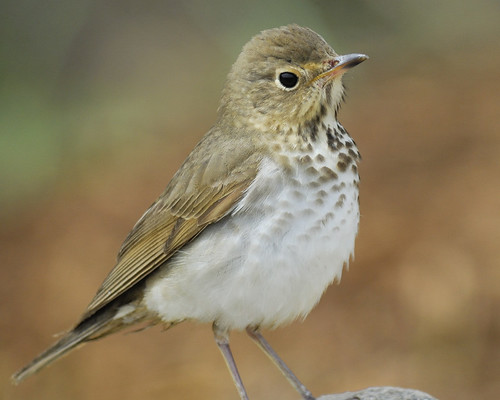tags: Swainson's Thrush, Olive-backed Thrush, Catharus ustulatus, birds, mystery bird, bird ID quiz
[Mystery bird] Swainson's Thrush, also known as the Olive-backed Thrush, Catharus ustulatus, photographed at Quintana Neotropical Bird Sanctuary, Brazoria County, Texas. [I will identify this bird for you in 48 hours]
Image: Joseph Kennedy, 27 April 2010 [larger view].
Nikon D200, Kowa 883 telescope with TSN-PZ camera eyepiece 1/400s f/8.0 at 1000.0mm iso400.
Please name at least one field mark that supports your identification.
More like this
tags: Red-legged Thrush, Turdus plumbeus,
tags: Yellow-Throated Laughing Thrush, Garrulax galbanus,
tags: White-throated Thrush, Turdus assimilis,
tags: Hermit Thrush, Catharus guttatus,


Well I'd like to know how to id this thrush - so lets get the conversation started :-)
Strong buffy eye-ring, buffy spots on chest, olive-ish upperparts .... makes me think of an eponymous thrush name, rather than a descriptive thrush name...
I'm thinking thrush too, though I'm not sure I get your thinking the name is eponymous. I'm missing something, probably.
I'm looking at my Sibley's, at a page with three different sorts of thrushes, all similar to this in many ways. Of the three, only one looks like it has more white than not, with darker spots on the breast. But this bird seems to have even fewer spots and to be whiter than that one.
I'm guessing a Hermit Thrush, based on the "Interior West" variant being fairly white on the undersides, with a pale tan/olive upper.
But, according to Sibley's, this one's also in Texas in winter, and in northern Texas for migration, but by April I'd think it would have moved into its breeding area. So I have my doubts. :/
Right. The descriptively-named one who shuns company has a streaked throat, not a spotted one, so I think we're talking about the eponymously-named offspring of a lover. But thrushes are *so* hard to tell apart.
Bardiac, usually with the Catharus thrushes (I'll include Wood Thrush, even though it's now in Hylocichla) the underside color and spotting is not the best mark to use. (Veery at one end and Wood Thrush at the other are exceptions, to an extent.) Instead, the face pattern and the color of the tail and head are the first things to focus on. This bird, as was mentioned, has a fair bit of buff on the face, and shows no rust or bright tawny on either the head or tail, suggesting that Ashok has it right on. Of course, the eastern races (including this bird) used to have a more descriptive name.
Thanks for explaining. I have so much to learn. (I was happy just to think "thrush" when I saw the pic first, so I'm getting a bit better.)